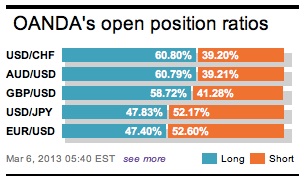It feels a tad unusual, but with so much noise of late in the different asset classes, this mornings financial markets are relatively calm. Investors seem to be accessing the significance of yesterday’s US equity milestone, while baring witness to Spanish yields falling on the back of their own governments assurance that the country is on track with its deficit reduction measures. Market risk sentiment could get a further boost from this afternoon’s US beige book, which is expected to show that US employment continues to grow.
The remainder of this week will be dominated by a plethora of G7 Central banks rate announcements. The standout messages will begin with Canada later this morning, Japan this evening and ending with Draghi’s ECB in Europe tomorrow. Into the mix will be thrown some North American employment numbers, beginning with this morning’s US’s ADP employment release for February, where consensus expects a +170k headline print. Although US rates should react to a notable surprise in either direction, Friday’s “granddaddy” of economic indicators, US non-farm payrolls print, is the headline economic data event this week and will remain the main focus for the US ‘rates’ market.

It’s the penultimate day of decision making for Governor Carney before he heads across the Atlantic to work for the “Old Lady.” The Bank Of Canada will announce its interest rate decision Wednesday morning. Canadian Policy makers are expected to keep their overnight interest rate on hold at +1%. This is very much “in the face” of a weak round of domestic indicators that has helped to weaken the loonie approximately -3.6% since the central bank’s last meeting.

Will the “new in-waiting” Governor of the BoE continue to preside over a mild tightening bias theme at the BoC who last time indicated that the withdrawal of monetary policy stimulus was “less imminent than previously anticipated”? Loonie trading seems to have consolidated ahead of the rate announcement. Despite the “big” dollar performing better on the back of risk appreciation after yesterday’s solid US non-manufacturing index and a record equity index print, the inherent danger is that the forex market may have the BoC figured all wrong. At current levels, the true risk award of trading would be to see an appreciation of the CAD after the communiqué.
To date, the market seems to have been pricing in a BoC easing up on its tightening bias. The problem is that a large percentage of this forex market has missed out on the bulk of the CAD weakness experienced over the past five-months. In fact, since then investors have mostly being playing catch up with ‘fast money’ pushing the CAD lower. Under this scenario, the momentum for further dollar weakness becomes limited at best.
Draghi is hanging tough ahead of the ECB’s rate announcement tomorrow. This market has yet to be wholly convinced that the current Italian political debacle will not become an inherent threat to hard worn stability that Euro-policy makers have seemed to be fighting for over so many months. The current EUR value is much weaker than at the last meet, giving policy makers no real cause to discuss exchange rates or so we think.
Certainly not helping Euro policy maker’s decision-making is this morning’s announced Euro-export numbers for Q4 (-0.9%) from the 17-members that use the single currency. The headline print happened to fall at the fastest rate in four-years and would suggest that the EUR’s recent rise is damaging the regions chances of a swift economic recovery. The figures are also strong proof that the whole region has been in recession for much longer than previously thought.
However, despite some weaker Euro-data points of late and with some futures dealers trying to price in a refinance-rate cut, the bolder move by ‘powers that be’ at the ECB would be to prudently keeps rates on hold. It’s sensible for policy makers to keep something in reserve, especially in case of escalating political problems actually occurring in Italy. Signposting a rate cut would probably only temporarily boost confidence and a -25bp rate cut now would actually do very little to the real economy in the short to medium term. By end of day, Euro-policy makers have to make the peripherals economies more competitive through reform. This ‘house of cards’ scenario requires growth for their EUR pet project to survive.

For the EUR outright, a break below Monday’s low of 1.2982 is badly needed to weaken the intra-day price structure. So far, strong resistance above the somewhat magnetic 1.3100 level is limiting recovery attempts. The forex market needs to hear the plethora of Central Banks rhetoric input before embarking on the next EUR adventure leg with any conviction.

Other Links:
Buy EURO Rumor; Sell Hard Fact, Tact Worth Preserving?
This article is for general information purposes only. It is not investment advice or a solution to buy or sell securities. Opinions are the authors; not necessarily that of OANDA Corporation or any of its affiliates, subsidiaries, officers or directors. Leveraged trading is high risk and not suitable for all. You could lose all of your deposited funds.


